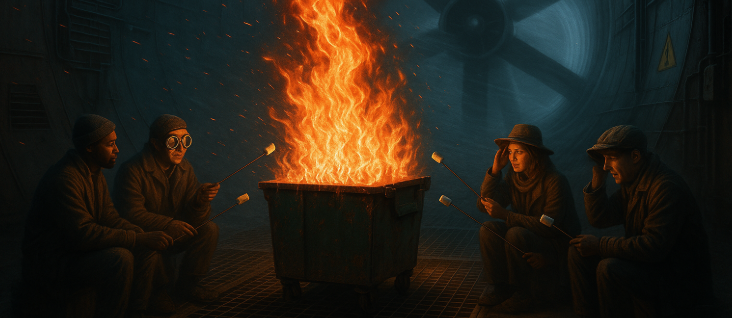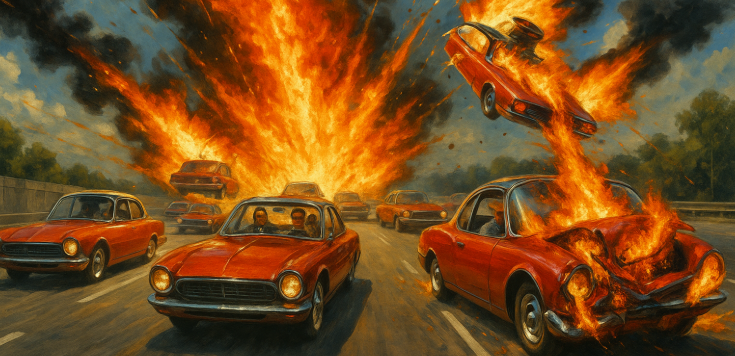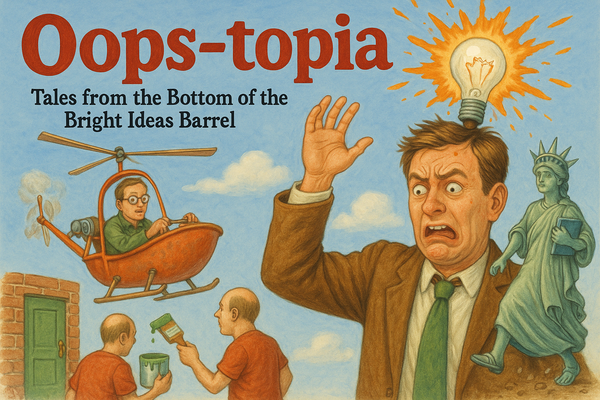Museum of Magnificent Mistakes
There exists a sacred place in the collective human psyche—a glittering hall of infamy where logic takes a coffee break, and reason calls in sick. This is where bad ideas go to die gloriously and rise again as Great Stories.
Welcome, dear reader, to the world where ambition wore blindfolds, where confidence ran faster than competence, and where people truly believed that leeches were the answer to everything.
You’ve heard the saying, “History is written by the victors.” Bullshit. History is written by the losers—the ones who messed up so colossally, so theatrically, that we had to immortalize their faceplants. Some of the best stories in history have started with a monumentally stupid idea. Let’s face it: humanity’s greatest talent isn’t innovation, art, or even war—it’s coming up with spectacularly bad ideas and then pretending they were meant to fail all along. We are divinely talented at making bad decisions with Olympic-level confidence and some of the worst decisions have given us the best stories, after all human history isn’t a carefully curated museum of genius. It’s a dumpster fire in a wind tunnel, and we’re all just toasting marshmallows around it.

Sure, we remember the great triumphs—Edison’s light bulb, Newton’s apple-induced physics epiphany to Steve’s Apple—but where’s the fun in success, I mean “other’s success”, who’s even interested in that, right? The real entertainment lies in the misfires, the misguided optimism, and the spectacular crashes that leave behind tales so ridiculous, they become legend. Because if history teaches us anything, it’s that humanity is exceptionally talented at making terrible decisions—and then doubling down on them.
Somewhere between genius and idiocy, there’s a truth we’re all afraid to admit: We’re addicted to failure. The Trojan Horse? A logistical nightmare. The Ford Nucleon? A Chernobyl waiting for a traffic jam. Twitter becoming “X”? A billionaire’s midlife crisis disguised as free speech.
History just loves screw-ups and we love these stories because they’re not just about failure. They’re about us. Before we dive into the labyrinth of historical gaffes, corporate oopsies, and personal train wrecks, let's take a moment to appreciate the bizarre genius of the human species: we fail with flair. We don’t just mess up—we build statues of our blunders, write books about them, and sometimes, if we’re lucky, IPO them into unicorns.

This article is a celebration of failure—not the motivational poster kind with soaring eagles and Helvetica fonts, but the kind that gets you roasted in a group chat or etched in history books with a permanent side-eye. This is a war cry for the defeated, the delusional, and the daringly dumb.
So buckle up. We’re about to take a joyride through the flaming wreckage of decisions that should’ve been sleepily ignored but instead became legacy-defining disasters. And remember:
“Experience is simply the name we give to our mistakes.” – Oscar Wilde
Let’s get experienced.
The Bold, The Brainless & The Brainfarts

History is not a straight line. It's a spiraling loop of bad decisions executed with great enthusiasm. Every empire, company, and unfortunate intern has at some point contributed to this rich compost of blunders from which future generations will desperately try (and fail) to learn.
The Original Phishing Email
We’ve talked about this majestic disaster already, but it deserves a little more airtime. The ancient Greeks, in all their philosophical brilliance, also had moments of breathtaking stupidity. Case in point: the Trojan Horse. Historians still debate whether this legendary wooden equine was real, but one thing’s for sure—it’s the ancient equivalent of opening an email from a Nigerian prince. The Trojans, seeing a giant wooden horse mysteriously left outside their city, collectively thought, “Yes, let’s bring it inside our fortified walls.”
This is the same level of judgment that later led people to believe drinking mercury would grant immortality. And much like clicking a suspicious link today, the Trojans got hacked—except instead of losing their Facebook account, they lost their entire city.
The Age of Leeches and Lunacy
Before science became peer-reviewed and annoying, it was mostly guesswork wrapped in confidence. Case in point: Leeches - Medical professionals (few centuries ago) for centuries believed bloodletting was the key to health. Got a fever? Leech. Depression? Leech. Snake bite? Double leech. Probably didn’t help, but it sure gave doctors something to do.
Brilliance Optional, Regret Guaranteed
Nuclear Powered Cars - Yes, this was a thing. In the 1950s, Ford unveiled the Ford Nucleon—a car powered by a mini nuclear reactor. The catch? They hadn’t figured out how to make a safe reactor that small. But who needs brakes when you have a mushroom cloud?
Sometimes, science isn't about solving problems. It's about asking, “What if we made it explode?”

Bad ideas don’t discriminate—they love infiltrating boardrooms just as much as battlefields. In-fact, corporate history is a buffet of deliciously bad decisions that make you wonder how some people managed to wear pants in the morning, let alone run a company.
Corporate Hall of Shame: COVFEFE
Imagine being Coke, you're literally the drink of the gods (and diabetes). But someone, probably an overpaid marketing exec, in a dazzling display of overthinking, decided in 1985 that their century-old formula wasn’t good enough. The result? New Coke—an attempt to fix what wasn’t broken. Public outrage ensued, customers hoarded classic Coke like it was the last food supply on Earth, and Coca-Cola executives had to reverse course faster than a politician caught in a scandal.
It was as if someone at Coke HQ woke up one day and thought, “What if we make our best-selling product taste slightly worse?” and everyone in the room just nodded. As Steve Jobs once said, “Innovation is saying no to a thousand things.” Clearly, Coca-Cola missed that memo.
We Indians aren’t immune to high-stakes blunders wrapped in good intentions. Even the legendary Ratan Tata took one on the chin with the Nano. Billed as the “world’s cheapest car,” it was a moonshot meant to put India on four wheels. But somewhere between the drawing board and the dealership, the messaging went from “affordable innovation” to “budget embarrassment.”

In his own words, Tata later admitted, “We branded it as cheap, when we should’ve said affordable.” And there it was—the Nano, a perfectly decent car that looked like a solid upgrade from a scooter, but unfortunately screamed, “This is all I could buy.” Turns out, no one wants to roll up to a wedding looking like the brand ambassador of frugality.
Let's talk about another boardroom classic covfefe, in 2000, Netflix’s co-founders approached Blockbuster (WHO?) for a $50 million acquisition deal. Blockbuster execs laughed them out of the room. Fast forward to today: Blockbuster is a trivia question, and Netflix is the reason you don’t talk to people at parties.
"Risk comes from not knowing what you're doing." – Warren Buffett
Buffett, by the way, once bought Dexter Shoe Company in the '90s with $433 million worth of Berkshire Hathaway stock. It later went completely bust. “The worst deal I’ve ever made,” he admitted. That's right—Buffett screwed up. But he owned it. Like a boss.
Strategic Faceplants: Military Masterpieces
There’s a special place in the Museum of Magnificent Mistakes for wars started on the premise of “We’ll be in and out in six weeks.”
The Vietnam War was one such masterpiece. A political black hole dressed up as a noble crusade, where the world’s most powerful military machine couldn’t figure out how to win against an army in flip-flops hiding in the jungle. Billions of dollars, tens of thousands of lives, and years of body bags later, it ended with one of the most iconic helicopter-on-the-rooftop GTFO scenes in modern history.
Robert McNamara, the U.S. Secretary of Defense during much of the war, later admitted, “We were wrong, terribly wrong.” A little late, Bob, but we appreciate the candor.
And let’s not forget the Maginot Line—a glorious concrete belt France built to stop the Nazis in WWII. Except the Germans just walked around it. Think of it as building a massive wall to keep out pigeons, only for them to fly over it and poop on your head anyway.

Sometimes, we don’t need enemies. We’re perfectly equipped to sabotage ourselves especially when you forget the one universal truth in military history, it’s this: don’t invade Russia in the winter. Especially if you’re wearing uniforms designed for Paris, not the Arctic Circle.
But Hitler, in all his delusional grandeur, looked at Napoleon’s icy disaster a century earlier and said, “Hold my schnitzel.”

What followed was a masterclass in hubris. German tanks froze. Soldiers froze. Supply lines broke faster than Hitler’s grasp on reality. The Red Army, armed with grit, vodka, and weather that could humble a god, chewed through the Nazi war machine like frostbite through fingers. It wasn’t just a strategic blunder—it was ego playing chess with common sense and getting checkmated by -40°C.
Moral of the story: history doesn’t just repeat itself—it rolls its eyes when you don’t pay attention.
Infrastructure Fails - When Concrete met Comedy
In the annals of WTF engineering, let us not forget the “Bridge to Nowhere” in Alaska—an actual $398 million project that linked a small town to… well, nothing. It became the poster child for government waste and the kind of decision-making that screams, “We had the budget, and no clue what to do with it.”
Or a similar failed project in Africa—an expressway connecting two cities that never got completed because someone forgot to, you know, buy the land in between. And then there are times when you do everything by the book—permits in place, engineering flawless, budgets approved—and boom! Nature pulls a plot twist straight out of a disaster movie. Case in point: Honduras, where engineers built a state-of-the-art bridge over the Choluteca River… only for hurricane 'Mitch' to show up, reroute the entire damn river, and leave the bridge majestically spanning absolutely nothing.

You can’t make this stuff up. The bridge was perfect. The river just… moved.
Personal Screw-Ups
Hold on, hotshot. Did you forget this whole essay is about other people’s disasters? Let’s get one thing straight: this isn’t about my trainwrecks. Yeah, my own screwups are a goldmine of cringe, and if you want a front-row seat to my dumpster fire of poor life choices? Fine—but that’ll cost you a bottle of bourbon and a signed waiver. Today’s sermon is about other people’s catastrophes, not therapy our way through my issues. My shame spiral gets its own TED Talk another time.
Why we keep screwing Up?
Let’s face it—bad ideas feel good. They’re exciting. They come with the dopamine hit of “what if.” They make us feel alive… right until they crash into a reality wall. Mark Manson said it best: "Happiness comes from solving problems. The keyword here is ‘solving.’ Not ‘avoiding,’ not ‘denying,’ but ‘solving.’"
Bad ideas give us problems. Epic, embarrassing, sometimes expensive problems. And those problems? They’re the stepping stones to wisdom. Or at least a decent stand-up routine.
We don’t get it right most of the time. And that’s okay. Because failure is the universal default setting. It’s the gritty, embarrassing, meme-worthy glue that binds us all. Behind every great innovation is a trail of errors so laughable, they deserve a Netflix docuseries. Behind every wise leader is a path paved with “what the hell was I thinking” moments.
So let’s raise a toast to our collective idiocy. Let’s celebrate the bone-headed decisions, the ill-advised investments, the relationships that ended faster than a WiFi signal during a Zoom call. Let’s give our mistakes their rightful place—not as stains to scrub out of our story, but as plot twists that make life worth reading.

Because if failure teaches us one thing, it’s this: You’re not broken. You’re debugging.


